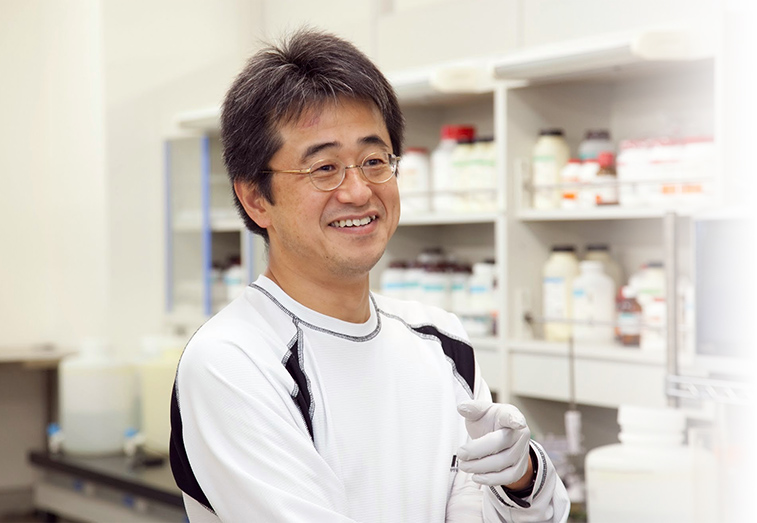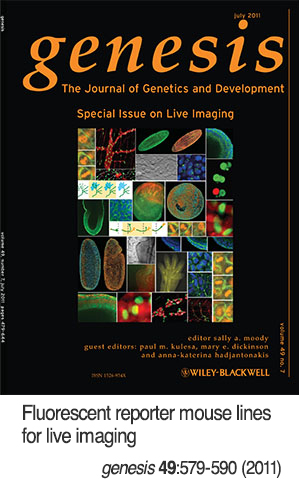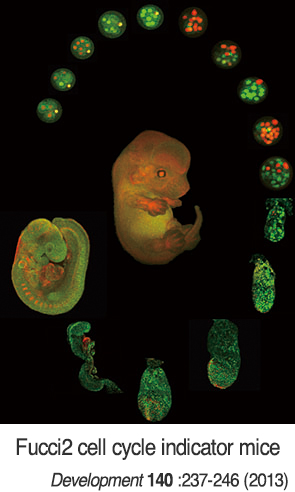
Team Leader
Yasuhide Furuta
Ph.D.
[Closed Mar. 2019]
Genetically engineered mice are one essential tool in modern biomedical research. The quality and efficacy of studies are greatly dependent on how efficiently mutant mice can be generated and propagated for various analyses. The major mission of the Genetic Engineering Team is to promote technical advancement of the generation of genetically engineered mouse models that are useful for biomedical research. In particular, our recent studies have focused on the development of new tools and technologies to understand biological dynamics by visualization of mouse development at the levels of tissue, cell, organelle, and developmental signaling. In addition, genome editing tools have been utilized to aid in efficient generation of multi-gene mutant strains that can often been difficult to achieve in conventional genetic crosses. Using technical expertise and knowledge gained through these studies, in close coordination with Animal Resource Development Unit, our team works with research labs within the RIKEN Institutes and Centers, as well as others in Japan and throughout the Asia-Pacific region to develop genetically engineered mice useful for biomedical research. In these joint development projects, we receive sequence information of the subject genes from our collaborators, and perform all subsequent stages of mutant mouse production from construction of the targeting vectors to the generation of chimeras, making about one hundred new mutant mouse lines every year.
Research Theme
- Development of genetically engineered mice useful for biomedical research
- Development of mouse genetic tools and techniques for bioimaging
Selected Publications
Morita R, Sanzen N, Sasaki H, et al.
Tracing the origin of hair follicle stem cells.
Nature (2021) doi: 10.1038/s41586-021-03638-5
Kiyonari H, Kaneko M, Abe T, et al.
Dynamic organelle localization and cytoskeletal reorganization during preimplantation mouse embryo development revealed by live imaging of genetically encoded fluorescent fusion proteins.
Genesis. 57(2). e23277 (2019) doi: 10.1002/dvg.23277
Satake T, Yamashita K, Hayashi K, et al.
MTCL1 plays an essential role in maintaining Purkinje neuron axon initial segment.
The EMBO Journal 36(9). 1227-1242 (2017) doi: 10.15252/embj.201695630.
Shioi G, Hoshino H, Abe T, et al.
Apical constriction in distal visceral endoderm cells initiates global, collective cell rearrangement in embryonic visceral endoderm to form anterior visceral endoderm.
Developmental Biology 429(1). 20-30 (2017) doi: 10.1016/j.ydbio.2017.07.004.
Nakao H, Harada T, Nakao K, Kiyonari H, et al.
A possible aid in targeted insertion of large DNA elements by CRISPR/Cas in mouse zygotes.
Genesis 54(2). 65-77 (2016) doi: 10.1002/dvg.22914
Toya M, Kobayashi S, Kawasaki M, et al.
CAMSAP3 orients the apical-to-basal polarity of microtubule arrays in epithelial cells.
Proceedings of the National Academy of Sciences of the United States of America 113(2). 332-337 (2016) doi: 10.1073/pnas.1520638113
Hayashi K, Momoi Y, Tanuma N, et al.
Abrogation of protein phosphatase 6 promotes skin carcinogenesis induced by DMBA.
Oncogene34(35). 4647-4655 (2015) doi: 10.1038/onc.2014.398
Kurimoto K, Yabuta Y, Hayashi K, et al.
Quantitative Dynamics of Chromatin Remodeling during Germ Cell Specification from Mouse Embryonic Stem Cells.
Cell Stem Cell 16(5). 517-532 (2015) doi: 10.1016/j.stem.2015.03.002
Susaki EA, Tainaka K, Perrin D, et al.
Whole-brain imaging with single-cell resolution using chemical cocktails and computational analysis.
Cell 157(3). 726-739 (2014) doi: 10.1016/j.cell.2014.03.042
Ishiguro K, Kim J, Shibuya H, et al.
Meiosis-specific cohesin mediates homolog recognition in mouse spermatocytes.
Genes & Development 28(6). 594-607 (2014) doi: 10.1101/gad.237313.113
Lee J, Kim KE, Choi DK, et al.
Angiopoietin-1 guides directional angiogenesis through integrin αvβ5 signaling for recovery of ischemic retinopathy.
Science Translational Medicine 5. 203ra127 (2013) doi: 10.1126/scitranslmed.3006666
Abe T, Fujimori T.
Reporter mouse lines for fluorescence imaging.
Development, Growth & Differentiation 55(4). 390-405 (2013) doi: 10.1111/dgd.12062





